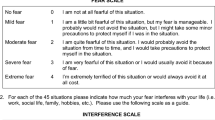Abstract
We examined fear induced by the magnetic resonance imaging (MRI) procedure in 80 adult patients who were undergoing the procedure for the first time. Participants completed self-report measures of claustrophobia, anxiety sensitivity, thoughts about the scan, and pain. Participants were assessed pre- and postscan, and at 1-month follow-up. Twenty-five percent of the participants experienced moderate to severe anx iety during the MRI scan. Prescan scores on the Claustrophobia Questionnaire (CLQ: Rachman and Taylor, 1993) significantly predicted participants' distress during the scan; pain and anxiety sensitivity did not. Furthermore, CLQ scores discriminated between participants who reported panic during the scan and participants who did not report panic. A brief screening instrument consisting of six items from the 29-item CLQ is suggested. This brief screening instrument administered prior to the scan may help identify in advance those people who are most likely to experience claustrophobic fear and, in particular, those who panic during the MRI procedure.
Similar content being viewed by others
References
Bernstein, D. A., and Kleinknecht, R. A. (1982). Multiple approaches to the reduction of dental fear. J. Behav. Ther. Exp. Psychiat. 13: 287–292.
Booth, R., and Rachman, S. (1992). The reduction of claustrophobia I. Behav. Res. Ther. 30: 207–221.
Fishbain, D., Goldberg, M., Labb, E. D., Zacher, D., Steele-Rosomof, R., and Rosomoff, H. (1988). Long-term claustrophobia following magnetic resonance imaging. Am. J. Psychiat. 145: 1038–1039.
Getka, E. J., and Glass, C. R. (1992). Behavioral and cognitive behavioral approaches to the reduction of dental anxiety. Behav. Ther. 23: 433–448.
Kanal, E., Shellock, F. G., and Talagala, L. (1990). Safety considerations in MR imaging. Radiology 176: 593–606.
Katz, R. C., Wilson, L., and Frazer, N. (1994). Anxiety and its determinants in patients undergoing magnetic resonance imaging. J. Behav. Ther. Exp. Psychiat. 25: 131–134.
Kilborne, L. C., and Labbe, E. E. (1990). Magnetic resonance imaging scanning procedures: Development of phobic response during scan and at one-month follow-up. J. Behav. Med. 131: 391–401.
Kleinknecht, R. A. (1991). Dimensions of blood/injury and medically related fears: Development of the Medical Fears Survey. Paper presented to the 25th Annual Meeting of the Association for Advancement of Behavior Therapy, New York, Nov.
Klonoff, E. A., Janata, J. W., and Kaufman, B. (1986). The use of systematic desensitization to overcome resistance to magnetic resonance imaging (MRI) scanning. J. Behav. Ther. Exp. Psychiat. 17: 189–192.
McNally, R. J. (1990). Psychological approaches to panic disorder: A review. Psychol. Bull. 108: 403–419.
Melamed, B. G., and Williamson, D. J. (1991). Programs for the treatment of dental disorders: Dental anxiety and temporomandibular disorders. In Sweet, J. J., Rozensky, R. H., and Tovian, S. M. (eds.), Handbook of Clinical Psychology in Medical Settings, Plenum, New York, pp. 539–565.
Melendez, J., and McCrank, E. (1993). Anxiety-related reactions associated with magnetic resonance imaging examinations. JAMA 270: 745–747.
Melzack, R. (1975). The McGill Pain Questionnaire: Major properties and scoring methods. Pain 1: 277–299.
Peterson, R., and Heilbronner, R. (1987). The Anxiety Sensitivity Index: Construct validity and factor analytic structure. J. Anx. Disord. 1: 117–121.
Quirk, M. E., Letendre, A. J., Ciottone, R. A., and Lingley, J. F. (1989). Anxiety in patients undergoing MR imaging. Radiology 170: 463–466.
Rachman, S. (1990). Fear and Courage, 2nd ed., Freeman, New York.
Rachman, S., and Taylor, S. (1993). Analyses of claustrophobia. J. Anx. Disord. 7: 1–11.
Radomsky, A. S., Teachman, B. A., and Rachman, S. (1997). The predictive validity of the Claustrophobia Questionnaire (CLQ). Poster presented at the annual convention of the Canadian Psychological Association, Toronto, June.
Reiss, S., Peterson, R. A., Gursky, M., and McNally, R. J. (1986). Anxiety sensitivity, anxiety frequency and the prediction of fearfulness. Behav. Res. Ther. 24: 1–8.
Shafran, R., Booth, R., and Rachman, S. (1993). The reduction in claustrophobia II: Cognitive analyses. Behav. Res. Ther. 31: 75–85.
Taylor, S. (1996). Anxiety sensitivity: Theoretical perspectives and recent findings. Behav. Res. Ther. 33: 243–258.
Author information
Authors and Affiliations
Rights and permissions
About this article
Cite this article
McIsaac, H.K., Thordarson, D.S., Shafran, R. et al. Claustrophobia and the Magnetic Resonance Imaging Procedure. J Behav Med 21, 255–268 (1998). https://doi.org/10.1023/A:1018717016680
Issue Date:
DOI: https://doi.org/10.1023/A:1018717016680




